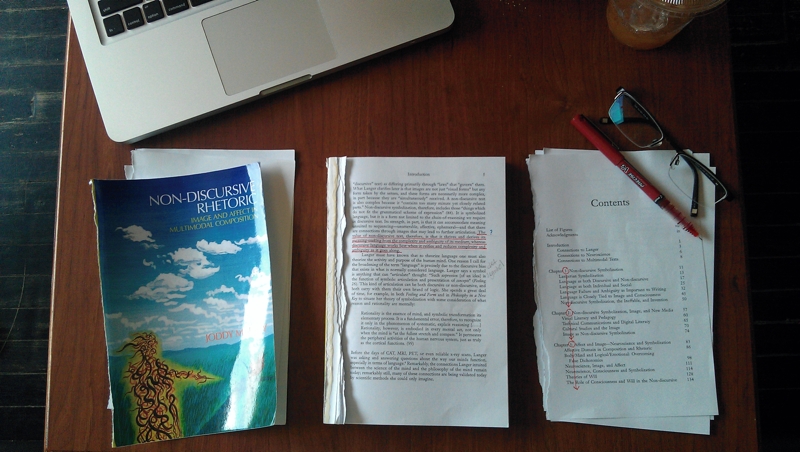This layer allows you to explore the implications of Murray's philosophy of mind for composition theory and practice.
In the closing pages of his book, Murray proposes five general values of multimodality,
values that grow out of his image-based re-working of composition theory, and that might fruitfully inform how we teach composition, particularly multimodal composition. These values, Murray explains, represent ways of producing meaning within texts. He cautions, however, that these values are not principles or rules or dictums or anything very solid or procedural,
because texts are always complexly situated, and results always unpredictable (p. 173).
The visual below is my attempt at a (rather quick-and-dirty) non-discursive composition, inspired by Murray's five values. Hopefully, this composition will provide one useful illustration of how Murray's values might inform the production and evaluation of texts. Click any of the values below to learn more.
| Image | Unity | Layering | Juxtaposition | Perspective |

Image
Students, according to Murray, need to be taught how to read and write
images of all sorts and senses—from words to visual images to the smell of a popcorn booth at a carnival
or the texture of a glossy magazine
(p. 175).
But what does it mean to read and write
images? For Murray, this involves more than simply literacy,
if literacy is just the ability send & receive
or upload & download
images in the mind. Students need what we might call a second-layer, or meta-, or rhetorical awareness of images. In other words, they need to see how images are constructed, altered, re-altered, and rhetorically invented
(p. 174). While many students may be able to perceive how verbal images—words—are used rhetorically, they may not be able to this with other species of image. Consider the photograph: Photographs are by no means new to students, but thinking about how they might be used to create an argument probably is new
(p. 174). To begin, for example, we might ask questions like, how does the angle of the camera affect the presentation of its subject?
Of course, students are often eager to include various images, including photographs, within essays, presentations, and so on—as support
or clip art.
But for Murray there is a big difference between image-as-support and image-as-text-in-and-of-itself. It is true, of course, that an image can effectively support or supplement discursive text. However, an image can also stand alone as non-discursive text, can "be articulate of its own meaning, can persuade on its own merit, and be comprised of complex layers of meaning and emotion" (p. 177).
Take my composition, above, which I'll call "The Reviewer." Certainly, this photograph can be read as support for the (largely discursive) book review you're reading right now. The photograph displays the cover of the book being discussed, and—if you look closely enough—you could also take away some information about the book's contents, from the open pages. But to read the image this way is to read it as a support, and not as a text. What happens then if we approach this photograph as a non-discursive text?
First, we notice that the cover of Non-Discursive Rhetoric has been, somewhat roughly, torn off. We notice stark red highlighting in the book, and some arrows drawn through the table of contents. We notice the red pen placed next to a pair of glasses, and, toward the edge of the frame, a laptop computer. Now what do we do with these elements?
To read the photograph as a simple support—as clip art—for the umbrella text, we would read these elements as information. But to read the photograph as non-discursive text is to read for meaning and feeling.
Isn't there a way to articulate these elements, for instance, into a critique of the review genre? After all, there are hints of violence here—the torn pages, the blood-red pen—as well as traces of the reviewer's (intrusive?) subjectivity, personality, body: here are his glasses, his computer, his half-drank iced coffee. Does this photo/text suggest that the review genre, perhaps unethically, tends to conceal any trace of the reviewer?
It seems to me that we could also articulate these elements into a critique of the book itself. Note, for example, the tension between the book's title—Non-Discursive Rhetoric—and the open page, which is thick with linear, verbal text, and has been placed (strategically? ironically?) beside it. Is this text suggesting that Murray's book fails to put its money where its mouth is?
The point of asking such questions about a non-discursive text, Murray suggests, would not be to decide upon a fixed-and-final meaning for it, as we might do with a discursive text. The point, rather, would be to draw on the complexity and ambiguity that resides in non-discursive text. But there is even more to non-discursive text than complexity and ambiguity: as Murray repeatedly insists, non-discursive text also carries affect, carries feeling that cannot be reduced to argument, however complex or ambiguous that argument may be. Perhaps, then, what we might draw from The Reviewer
is not only the questions and ideas I've sketched above, but also something about what it feels like to write a review, or to live the lifestyle of an academic.
Unity
When we compose non-discursively, we aren't composing indiscriminately or without awareness of form. Achieving unity is just as important here as it is in a discursive essay.
Unity for Murray means helping a viewer focus their attention
(p. 177). Or, put differently, establishing unity means ensuring that all the various elements of a composition are in dialogue
(p. 178).
In the discursive essay, unity might be achieved simply by offering a clear thesis. In non-discursive texts, however, unity is composed differently—and only with great difficulty. As Murray points out, because single-medium genres like the 8.5" x 11" discursive essay are so constrained visually and formally, a certain amount of unity is inevitable. This is not the case in, for instance, the digital realm, where constraints are fewer, and the choices facing a composer multiply in number and mushroom in importance.
Insightfully, Murray also points out that unity is relative, and specifically relative to audience and purpose:
[U]nity can only be achieved if the audience is taken into consideration. Academic audiences, not surprisingly, will expect clear unity just like they expect (usually) a clear thesis; the local music scene in a specific community may not expect much unity at all, preferring a design that functions rhetorically to indicate informality and other possible countercultural denotations and connotations. (p. 178)
My composition, above, acheives Murray's unity insofar as it introduces elements that are in dialogue with one another. Even if viewers aren't led to the possible arguments I suggest in my write-up on image and layering, the composition seems to hold together visually, since it's a single photograph with uniform tone and coherent lines, for example. It also holds together conceptually, since there are elements that clearly relate to and inform one another, such as the pen and the highlighting, and the various kinds of text.
Murray's point that unity is relative, however, very much applies here. Clearly, this text would have far less unity for a general audience than it would for my intended one—scholars interested in digital rhetoric and composition, who would be familiar with the kinds of objects depicted and the various practical (book, red pen; coffee, computer) and conceptual (reviewer, review, book) relations between them.
TopLayering
How do the elements of a composition relate to one another? For discursive composition, the metaphor most often used to describe the ideal relationship between elements is the sequence.
For non-discursive and multimodal composition—which rely on no specific ordering
—Murray proposes that elements relate to one another as layers.
Layers are, or should be, dialogic,
producing tensions and resolutions
between elements. Understood most literally, layers appear wherever visuals appear adjacent to text, or sound adjacent to image. Layers might also describe the relationship between different nodes or section of a text, like this review, which offers different layers dealing with concepts, compositions, and conclusions, each with a different perspective.
Layers are dialogic, Murray continues, when they provide depth, texture, complexity, nuance, even contradiction: all of which is important in creating multimedia products that move beyond simple representation/illustration
(p. 178-179).
My composition, above, is layered insofar as its elements are in productive dialogue with one another. Is the image of long-form, linear, verbal text, for example, in tension with the title on the cover? Might this provide material for a critique of the book? What about the glasses at top-right? Does this hint of the reviewer's subjectivity add another, postmodern tension, reminding the viewer that this review, and this photograph, are artificially—and perhaps fatally—composed?
TopJuxtaposition
Murray identifies juxtaposition as his fourth value of multimodal composing. It isn't wholly clear what distinguishes juxtaposition from layering, though perhaps we can understand juxtaposition as a special style of layering—one designed to emphasize difference.
TopPerspective
Though non-discursive compositions might include many different kinds of elements, and though relations between those elements may be quite fluid, Murray insists that non-discursive compositions must nonetheless provide the viewer with a coherent perspective—a vantage point or a point of view
(p. 180).
Point of view
is a familiar spatial metaphor, but how exactly is Murray using it? What he seems to mean by perspective is this: rather than simply lumping a bunch of images together, composers should offer viewers an interpretive path or paths around and through those images. A text, in other words, should advise us how we might read it:
The value of perspective might also be thought of as reflective of the kind of imprint function requires of form. Put in usability terms, perspective ensures usability by integrating the audience into the interface. (p. 181)
Developing a perspective, then, is tied to developing unity, as well as developing a purpose or goal for a given composition.
If my composition, above, fails to meet up with any of Murray's five values, it is probably perspective. Does the photograph provide clear interpretive paths? In my explorations of unity and layering, I suggest a few interpretive paths: how to read the photo as a critique of the book, or as a critique of the review genre. Still, I am not sure whether, without my prodding, these perspectives would present themselves to viewers. To defend the composition, I might insist the horizontal alignment of the three piles provides a visual path, prompting the viewer to read them against one another; or that the red highlighting prompts the viewer to consider the red pen, and parallel to that, the glasses. While this may or may not lead the viewer to the same provisional arguments I have suggested, it does provide a path through the text, however feeble.
This, seemingly, is the primary challenge facing composers of non-discursive text: how to provide a coherent perspective or perspectives without reducing possible meanings, so that composers can take advantage of the complexity and ambiguity
that non-discursive composition can offer (p. 5).




